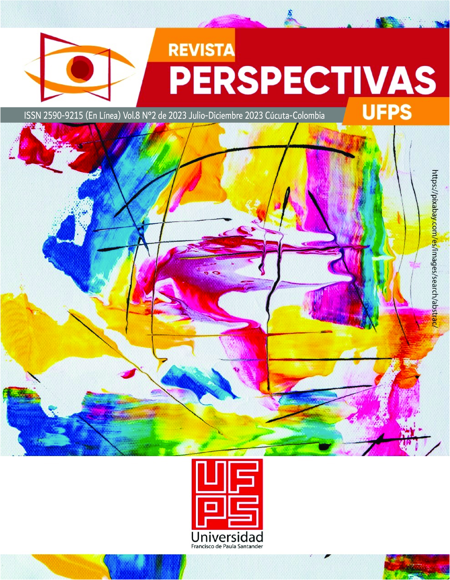Reliability and validity of the multiple intelligence questionnaire
Confiabilidad y validez del cuestionario de inteligencias múltiples
Main Article Content
This article describes the reliability and validity analysis of the Multiple Intelligences Questionnaire adapted by Walter McKenzie (1999), in search of having a reliable and valid test with which the multiple intelligences of Colombian students can be recognized and determined basic primary and secondary education. A probabilistic sampling was carried out by the multistage conglomerate method, the sample was made up of 573 students from the municipality of Cúcuta enrolled in 2020 and 2021, with ages between 8 and 16 years, with an average of 11,16 years and a deviation standard 1,37 years. Cronbach's alpha coefficient gave 0,828, of the reliability of the total instrument and values from acceptable to high for each of the intelligences. Confirmatory factor analysis (CFA) ratifies the eight dimensions that make up multiple intelligences theoretically proposed by Garnerd (1983) and adapted by Walter McKenzie (1999). It is concluded that the instrument to assess multiple intelligences evidences from the sample a high degree of reliability and statistical internal consistency. The above conclusion presents the appropriate instrument for the study of multiple intelligences in students in the Colombian context
Downloads
Article Details
Anastasi, A. (1990). Psychological testing (6ª. ed.). MacMillan Publishing Company
Arias, F. (2012). El proyecto de investigación. Introducción a la metodología de investigación científica. Editorial Episteme.
Bentler, P. M. (1990). Comparative fit indexes in structural models. Psychological Bulletin, 107, 238-246. http://doi.org/10.1037/0033-2909.107.2.238 DOI: https://doi.org/10.1037/0033-2909.107.2.238
Bentler, P. M., & Bonett, D. G. (1980). Significance tests and goodness of fit in the analysis of covariance structures. Psychological Bulletin, 88, 588-606. http://doi.org/10.1037/0033-2909.88.3.588 DOI: https://doi.org/10.1037/0033-2909.88.3.588
Browne, M. W., & Cudeck, R. (1993). Alternative ways of assessing model fit. En K. A. Bollen & J. S. Long (eds.), Testing structural equation models (pp. 136-162). Sage.
Brown, F. G. (1980). Principios de la medición en psicología y educación. Manual Moderno.
Cisneros, J. C., Chimbo, K. M., Trejo, C. A., Valdez, K. G., & Villardón, J. L. (2019). Análisis Multivariante de los Aspectos Emocionales y las Inteligencias Múltiples en la Era Digital. Revista Ibérica de Sistemas e Tecnologias de Informação, 2(18), 234-44.
Del Pino, M. (2013). Aplicación didáctica de las Inteligencias Múltiples. E-motion: Revista de educación, motricidad e investigación, (1), 103-116. DOI: https://doi.org/10.33776/remo.v0i1.2267
Fograty, R. (1991). How to Integrate Curricula. Colombia University Teachers College.
Gardner, H. (1983). Frame of Mind: The theory of multiple intelligences. Basic Book.
Gardner, H. (1993). Multiple Intelligences: The Theory and Practice. Basic Book.
Hajhashemi, K., & Eng, W. B. (2010). A validation study of the Persian version of McKenzie’s multiple intelligences inventory to measure profiles of pre-university students. Pertanika Journal of Social Sciences & Humanities (JSSH), 18(2), 343-355.
Hernández, C. A., Prada, R., & Rincón, G. A. (2018). Inteligencias múltiples y rendimiento académico del área de matemáticas en estudiantes de educación básica primaria. Infancias Imágenes, 17(2), 163–175. https://doi.org/10.14483/16579089.12584 DOI: https://doi.org/10.14483/16579089.12584
Iraurgi, I., Sanz, M., & Martínez-Pampliega, A. (2009). Adaptación y estudio psicométrico de dos instrumentos de pareja: índice de satisfacción matrimonial y escala de inestabilidad matrimonial. Revista IIPSI, 12(2), 177-192. DOI: https://doi.org/10.15381/rinvp.v12i2.3763
Kepheart, N. C. (1973). Learning Disabilities. Brown & Benchmark Publishers.
Lazaer, D. (2000). Development of Multiple Intelligences. McMillan.
Lévy, J. P., & Varela, J. (2003). Análisis Multivariable para las Ciencias Sociales. Pearson Educación.
Lizano, K., & Umaña, M. (2008). La teoría de las inteligencias múltiples en la práctica docente en educación preescolar. Revista Electrónica Educare, 12(1), 135-149. DOI: https://doi.org/10.15359/ree.12-1.10
Lord, F. M., & Novick, M. R. (1968). Statistical theories of mental test scores. Addison-Wesley.
Marrero, O., Mohamed, R., & Xifra, J. (2018). Habilidades blandas: necesarias para la formación integral del estudiante universitario. Revista Científica Ecociencia, 5, 1–18. https://doi.org/10.21855/ecociencia.50.144 DOI: https://doi.org/10.21855/ecociencia.50.144
Martini, E. (2014). Formal Multiple Intelligences Assessment Instruments for 4-6 Years Old Children. American Journal of Educational Research, 2(12), 1164-1174. https://doi.org/10.12691/education-2-12-6 DOI: https://doi.org/10.12691/education-2-12-6
MacKenzie, W. (1999). Cuestionario de detección de las Inteligencias Múltiples: ejemplar para el alumno de Secundaria.
Piaget, J. (1972). The Realm of the Child. Peacock.
Piaget, J. (1985). The equilibration of cognitive structures: The central problem of intellectual development. University of Chicago Press
Pohl, M. (2000). Learning to Think and Thinking to Learning. Hawker Brownlow Education.
Prieto, M. D., & Ballester, P. (2003). Las inteligencias múltiples. Diferentes formas de enseñar y aprender. Pirámide.
Rincón, G. A., & Aguilar, A. J. (2018). Las inteligencias múltiples como estrategia didáctica para mejorar el rendimiento académico de matemáticas en la básica primaria. En J. P. Salazar, Y. L. Contreras & J. F. Espinosa (Ed.), Investigación y Praxis en la Enseñanza de las Matemáticas (pp. 179-202). Ediciones Universidad Simón Bolívar.
Shearer C. B. & Luzzo, D. A. (2009) Exploring the application of multiple intelligences theory to career counseling. The Career Development Quarterly, 58(1), 3-14. DOI: https://doi.org/10.1002/j.2161-0045.2009.tb00169.x
Sospedra-Baeza, M. J., Martínez-Álvarez, I., & Hidalgo-Fuentes, S. (2022). Inteligencias múltiples, emociones y creatividad en estudiantes universitarios españoles de primer curso. Revista Digital de Investigación en Docencia Universitaria, 16(2), 1-15. http://doi.org/10.19083/ridu.2022.1153 DOI: https://doi.org/10.19083/ridu.2022.1153
Sternberg, R. J. (1994). Encyclopedia of human intelligence. Macmillan.
Sarwono, S.W. (1979). Inteligensi, apakah itu? Fakultas Psikologi, Universitas Indonesia.
Thorndike, R. L. (1996). Psicometría aplicada. Limusa.







